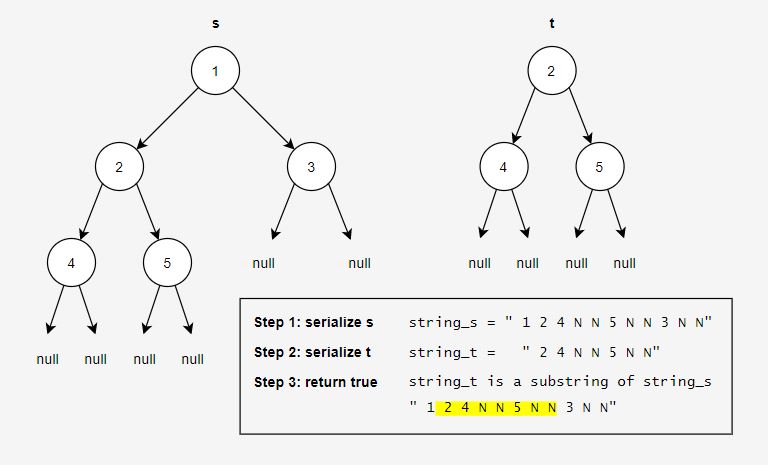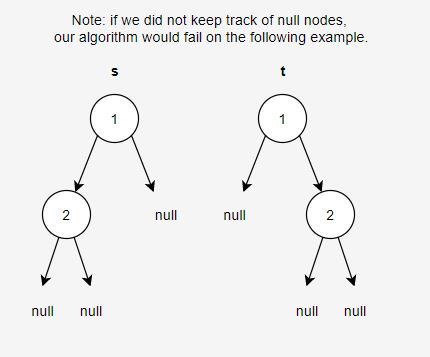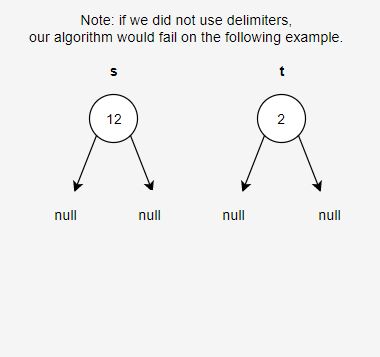LeetCode
Subtree of Another Tree
Approach 1: Brute Force ⭐
For every node in the bigger tree s, we want to check if it is the same tree as the smaller tree t. We use recursion to accomplish this:
- If the current node in s is the same tree as t, return true
- Otherwise, recursively check if the current node’s left child contains t as a subtree or if the current node’s right child contains t as a subtree
For more details or alternate implementations of isSameTree(), check out my explanation of LeetCode problem Same Tree.
Complexity Analysis
Let m = number of nodes in s
Let n = number of nodes in t
Time: \(O(mn)\)
In the worst case scenario, there are many duplicate values in s and t and we must check every node in t for every node in s.
Space: \(O(m)\)
Each recursive call takes up a stack frame and the worst case scenario occurs when s is skewed. Imagine we are \(m-x\) recursive calls
deep into isSubtree() when isSameTree() is called. It takes at most \(x+1\) recursive calls of
isSameTree() to reach a null child in s and verify that the current node is not t. Therefore, we will never use more than
\(m+1\) stack frames.
Approach 2: Reduction to Substring Problem (String, indexOf) ⭐
Another approach to this problem is to reduce it to the substring problem first. The algorithm for this approach consists of 3 steps:
- Serialize s - traverse the bigger tree s and store the order of the traversal in
string_s - Serialize t - traverse the smaller tree t and store the order of the traversal in
string_t - Return whether or not
string_tis a substring ofstring_s
Things to note:
- When we serialize a tree, we will use “N” to represent a null child.
- When we serialize a tree, we will use a space “ “ as a delimiter in the strings to separate node values.
- When we serialize a tree, we will traverse the nodes using a preorder traversal. If an inorder traversal or a postorder traversal is used instead, we would need to differentiate between left null children and right null children.
- When checking whether
string_tis a substring ofstring_s, we will use Java’s built in library functionindexOf(), which returns the index of the first occurrence ofstring_tinstring_s, and -1 otherwise.
Here is how the algorithm would work on the following input:

Here is an explanation for some of the bullet points above:


Below is the full solution:
Complexity Analysis
Let m = number of nodes in s
Let n = number of nodes in t
Time: \(O(m^2+n^2+mn)\)
With the code above, serializing s takes \(O(m^2)\) time. This is because String objects are immutable in Java. Therefore, when we
append to the string \(m\) times, we are actually creating \(m\) new strings, each with length \(O(m)\). Initializing a string of
length \(O(m)\) takes \(O(m)\) time, so initializing \(m\) strings of length \(O(m)\) takes \(O(m^2)\) time. This same reasoning is
why serializing t takes \(O(n^2)\) time. Lastly, the Java library function indexOf() takes \(O(mn)\) time. This is
because it uses a simple brute force substring algorithm.
Space: \(O(m^2+n^2)\)
Again, because strings are immutable in Java, we will end up creating \(m\) strings of length \(O(m)\) and \(n\) strings of length \(O(n)\). This will require \(O(m^2)\) and \(O(n^2)\) space respectively. In addition, serializing s and t require \(O(m)\) and \(O(n)\) stack frames, but this is negligible compared to the space required to store the strings.
Approach 3: Reduction to Substring Problem (StringBuilder, indexOf) ⭐
Using immutable strings was the primary cause of the previous approach’s bad time and space complexity. So let us use something mutable like StringBuilder or StringBuffer instead:
Complexity Analysis
Let m = number of nodes in s
Let n = number of nodes in t
Time: \(O(mn)\)
The limiting factor of the runtime for this algorithm comes from the Java library function indexOf(), which takes
\(O(mn)\) time. Serializing s and t now only take \(O(m)\) and \(O(n)\) time respectively.
Space: \(O(m+n)\)
We need \(O(m)\) space to store one StringBuilder and one String of length \(m\), and we need \(O(n)\) space to store one StringBuilder and one String of length \(n\). In addition, serializing s and t require \(O(m)\) and \(O(n)\) stack frames respectively.
Approach 4: Reduction to Substring Problem (StringBuilder, KMP) ⭐⭐
We can improve the asymptotic runtime of the previous approach even further by using a linear time pattern searching algorithm instead of the library function indexOf(). I have chosen to use KMP as my linear time substring algorithm below:
Note that typically KMP finds all occurrences of a substring in a string, but I have modified it to return true as soon as it finds one occurrence.
Complexity Analysis
Let m = number of nodes in s
Let n = number of nodes in t
Time: \(O(m+n)\)
Space: \(O(m+n)\)
Optimization Ideas:
- asdasd Morris Traversal
Approach 5: HashSet
Complexity Analysis
Let m = number of nodes in s
Let n = number of nodes in t